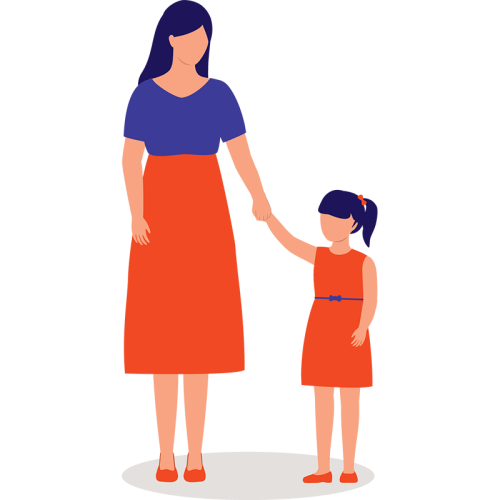How to Teach Accepting “No”
Hearing "no" can be hard for children, and they need to be taught how to tolerate being told "no." They will learn this best with clear rules and consistent follow through.
Goal

Overview
Very young children live in a world of “yes.” Their needs and wants (i.e. diaper, bottle, soothing, bed, etc.) are typically met and satisfied quickly and often. At some point, it becomes necessary to introduce them to the concept of “no” and teach them how to respond properly to it.
Children must be taught that when their parent (or other authority figure) says no, what they want will not be granted or allowed. This requires effective use of the word no (and its synonyms) by the parent and an appropriate response to it by the children. Although seemingly simple and easy, saying no effectively and responding to it appropriately are challenges for most people.
Method

Teach your child how to wait.
Learning how to wait is a necessary prerequisite to learning how to respond appropriately to the word no. Refer to Waiting Without the Fuss before starting this process.

Make sure “no” is the answer you want to give.
Saying “no” sometimes becomes the default answer. You may say it without even thinking and not mean it. Your child may learn that when you say “no,” there is a chance they can still get what they want if they continue asking for it or if they put up a big enough fuss. When you use the word “no,” say it and stick to it.
When “no” doesn’t always mean “no,” it will slow down your child’s ability to learn how to respond appropriately and limit its effectiveness in situations where it is very needed.
Pause and reflect on whether “no” is exactly what you mean to say before you say it. You can try saying, “not now,” “maybe later,” or “let me think about it,” if you are unsure.

Say “no” in a clear and direct way.
The way you say “no” is important. Say “no” once and in a neutral manner. Saying “no” loudly will not help your child understand the meaning of the word. They may tune into the volume of your voice and gradually learn that “no” does not mean anything unless it is said loudly.
If you repeat the word multiple times in one episode, it may lose its meaning during that and other episodes. It is best to say it once and then look at your child silently until it registers.

Teach your child to make another choice.
When something is not available, teach your child that they can make a different choice. You can begin teaching them by showing them that there are other good options.
Example:
Have a basket of items they enjoy playing with nearby so alternatives can be readily available. You can also tell them what other options they can choose from.
“Video games are not available right now, but you can play with Legos.”
If you know there are certain items that are not available when you are out and about, bring a few other options to play with. The ability to show your child that they have other choices is key.
Give another option
Adrianna asks for chips. Watch how her dad calmly and directly says no, and then offers her an alternative.

Give your child feedback.
Doing the right thing when they hear “no” will be hard at first, and your child will need feedback. Give praise or positive attention for any perceivable effort to stop or even slow things down when you tell them “no.”
Here are a few examples of what you can tell your child when they listen:
I like it when you do what I tell you to do.
Thank you for waiting.
You are learning self control really well.
If they don’t listen – continue what they’re doing, persist with their requests, ask someone else, or exhibit any response that indicates they do not intend to stop – then apply a disciplinary consequence (refer to the challenges section for more on not listening). For extra insurance, once you have said no, put the item of interest out of reach or the activity off limits and make sure all adults nearby know that you have said no.
Following Through on Your "No"
Adrianna starts to throw a tantrum when her dad says she cannot have chips. Notice how he calmly says no, gives her another option, moves the chips out of her reach, and then ignores her tantrum.
Answer with “yes” more often.
Try to use “no” less often than “yes.” Ideally, say “yes” at least five times as often as you say “no.” This accomplishes at least two good things. First, it increases the impact of your “no.” And second, it adds more fun to your relationship with your child.
Start saying “yes” if requests are possible and not harmful. For example, consider saying “yes” to your child if they want to sleep in the fort they made or if they want to wear funny shoes to dinner. If you are still inclined to say “no,” ask yourself why.
For example, if it’s a safety issue, could you modify the environment to make the area safe for your child to play? If so, consider making those adjustments so that your “no” can be turned into a “yes.”
Challenges
My child starts acting out.
If your child starts to act out (cry, throw a tantrum, etc.) when hearing “no,” stay neutral and avoid yelling or getting angry. Under no circumstances allow them to have the item or activity that they asked for. After they are calm, you can tell them what the available options are. Review Managing Tantrums and Dealing with Big Emotions for more helpful tips on dealing with acting out.
I want to prevent tantrums.
Give your child a heads up that what they want is not available. For example, anticipate that your child will ask for a doughnut at the grocery store, so before you go, tell your child, “We are just going in to grab milk. No treats.” If they believe there is a low probability of getting what they want, they’re much more likely to accept “no” appropriately than if they fully expect that you are going to say yes. Then, stick to your “no.”
My child has trouble waiting.
Revisit Waiting Without the Fuss. You may need to build up some more tolerance to waiting before practicing “no.”
My child has a meltdown when we practice.
Practice saying “no” to your child when they ask for moderately preferred items. It might be easier for your child to tolerate “no” when it’s something they don’t care about as much.
I avoid saying "no" to prevent tantrums.
The best way to learn how to respond to “no” is to have exposure to it. For this reason, you should not avoid saying “no.” Make sure you are following the other recommendations in this program, especially meaning “no” when you say it and saying “yes” more often!
Practice
Before you practice “no,” assess if your child can wait nicely (no protesting or acting out) for at least one minute. If they have a hard time waiting, refer to Waiting Without the Fuss for help. If they can wait nicely, practice accepting “no.”

Prepare
Get a few moderately preferred items that your child might want and show them to your child.

Apply
Wait for your child to ask for something. Alternate between honoring their request, asking them to wait, and telling them "no."

Repeat
Practice at least once a day.
Next Steps
Use "no" in real situations.
After your child can tolerate “no” in your practice sessions, begin to use these strategies in real situations. For example, if your child asks to go to a movie, you can use that natural opportunity to say, “No, but we can watch a movie at home.”
